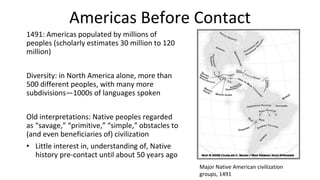
1 apush_lecture-_america_before_contact.pptx
- 1. Americas Before Contact 1491: Americas populated by millions of peoples (scholarly estimates 30 million to 120 million) Diversity: in North America alone, more than 500 different peoples, with many more subdivisions—1000s of languages spoken Old interpretations: Native peoples regarded as “savage,” “primitive,” “simple,” obstacles to (and even beneficiaries of) civilization • Little interest in, understanding of, Native history pre-contact until about 50 years ago Major Native American civilization groups, 1491
- 2. Americas Before Contact, cont. Modern historians: • Native peoples had a long history pre-contact, one which affected their interactions with Europeans Beringia Migration: • “Land Bridge” • Consensus: First Americans arrived in waves from 13,000 BCE to 3,000 BCE • “Paleo-Indians”—evidence of hunter- gathering societies in Chile—12,000 BCE Beringia migration, 13,000 BCE-3,000 BCE “Clovis” spearpoints from site in New Mexico—c. 12,000 BCE
- 3. Americas Before Contact, cont. Paleo-Indians: hunted megafauna (mastadons, horses, bison, etc.) in bands composed of kin groups—over time, evidence of trade and interaction 9,000 BCE: Massive die-off of large mammals • Warming climate, effectiveness of Paleo-Indian hunters • Led to lifestyle changes in temperate regions—hunting/gathering in villages, plant cultivation—Archaic peoples (c. 7000-2000 BCE)
- 4. Americas Before Contact, cont. Mesoamerica: site of first intensive agriculture • Began with maize, beans, squash— “three sisters”—became foundation for Mesoamerican societies • Agricultural techniques→surpluses→specialization • Complex societies/formal trade networks • Population density→hereditary chiefdoms • First states emerge near modern Mexico City (Teotihuacán) and Yucatan Peninsula
- 5. America before Columbus, cont. Incas—conquered Andes mountain empire by 1450s Southwestern peoples: • Hohokam—central Arizona, elements of Mesoamerican culture (platform mounds, ball courts, corn cultivation) • Ancestral Pueblo—powerful culture, also in decline by 14th century—”cliff dwellers”
- 6. Eastern Woodlands Mississippi Valley to Atlantic Ocean—temperate climate→dense population (large towns and villages) • Corn, beans, squash→primary food source by around 1000 A.C.E. Mississippian Culture: • Began around 800 A.C.E. in Mississippi River Valley • Large towns with platform mounds- towns were ceremonial and commercial centers • Wide-reaching trade networks ranged from Mesoamerica to northeastern North America • Powerful chiefs ruled from cities • Cahokia—Mississippian town of more than 40,000 people (located where modern St. Louis is today) Biggest city in North America from about 700 to about 1400 A.C.E., collapsed for unknown reasons. Cahokia was never surpassed in size in North America until after the American Revolution. • Elements of Mississippian culture influential throughout eastern North America (farming techniques, religion, mound building, etc.)
- 7. Cahokia: artist’s representation. Mounds and ball field were characteristic of Mississippian civilization
- 8. Other Indian peoples Northwest: settled lifestyle based on fishing, sealing, etc. (similar to Northeastern Canadian peoples) California: Acorn production/trade→large villages & polities Plains Indians: Nomadic, lived off buffalo herds, some settled farmers. The horse associated with Plains Indian life was accidentally introduced by Spanish invaders ***First contact between Norse and Indians in Newfoundland, C.E. 980
- 9. Generalizations about Native North Americans Indian people were very diverse pre-contact, but the following are some broad shared characteristics (though these are not universal): • Had a history: warred, traded, moved, conquered, died out, etc., centuries before European contact • Big towns and powerful chiefdoms falling apart before Europeans arrived. We aren’t sure why this was happening, but it was rapidly accelerated by the spread of disaeas. • Shared principles of kinship, reciprocity, and communal (not individual) ownership of resources. This was different from Europeans, whose laws allowed for individual, permanent, exclusive land ownership. • Many societies were matrilineal, meaning property and status was inherited from one’s mother. Indians had different understanding of gender roles than Europeans. For example, among Powhatan and other Algonquian peoples in Virginia and North Carolina, women handled farming duties. Among many eastern Indian peoples, women participated in political decision-making as well. • Strong belief in spiritual power (seen as no different than political/other forms of power). Unlike most Europeans, Native Americans did not differentiate between the spiritual and the secular world. • Most east of Mississippi & north to New England were agriculturalists and hunters